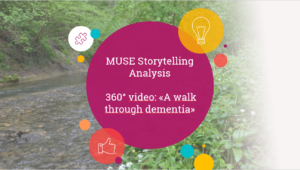Storytelling is the art of telling stories. And after the opinion of a lot of experts, our love for good stories is deeply related in our DNA. In stone age, sitting around the fire, humans liked to listen to stories of successful people, those who survived the hard fights against nature. Good storytellers were often the people who survived, who could tell you something precious. And since then up to now, storytelling has an important function in sharing knowledge – as we are programmed during centuries to give our attention to good stories.
What does this mean for us content strategists?
Going online is often an overwhelming experience – it is like «taking a drink from a fire hydrant», as Mitchell Kapor said once. And after my opinion, the only chance to catch people’s attention in that flood of information is telling good, interesting, fascinating stories. What does that mean? As content strategists, we have to produce stories of people or products with diligently chosen conflicts, stories that tell journeys, and stories with a well written, knowledge transferring ending. I will publish another essay about this topic of good storytelling, but for the moment let’s go on with my hypothesis: content strategy without storytelling is like a car without fuel. I think it is essential that we know what storytelling is about, what makes a good story – and how we can use these recipes for own projects.
Theory and practice on the master ‘content strategy’
This is exactly one approach of the master ‘content strategy’ at the FH Joanneum in Graz. During our module «Crossmedia and storytelling» we learned the basics of storytelling and got in touch with the MUSE principle. But theory is just one side of the coin. Early, we transferred that knowledge into praxis by analysing some self-chosen examples on our own. I choose a 360degree video from the non-profit organization Alzheimer’s Research UK. Virtual reality videos are relatively new – and I was curious to see, how this first steps with a new technology was combined with storytelling.
You could ask yourself now – why NGO? Why not another industry? I am working in a Swiss NGO on my own, so this explains my interest. But there is another reason: We NGO want to reach people with information. We want to affect some changes in human behaviours. And to talk efficiently to people, you must catch their attention. Nothing fascinates people more than a good story, as proven by endless articles about storytelling and last but not least Joseph Campbell’s well known book «The hero’s journeys» .
When NGOs create information for distribution, they benefit a lot from the recipe of good stories. Through watching and participating a story, humans are moved by their emotions. And emotions are essential for us to be able to decide, and to change something in our own lives. So, dear NGOs in the world: Don’t only talk about facts and figures. Connect these aspects with good stories – and your NGO will have bigger impact, reach more people, and change the world!
Have a look at my analysis of the 360° video «A walk through dementia»
Further information
My chosen example for the analysis
Website Alzheimer’s Research UK
